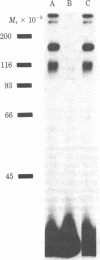Abstract
Epidermal growth factor (EGF) promotes hepatocyte growth and is bound in the liver by specific receptors. We have determined hepatic uptake of EGF in intact rats after an intravenous or intraportal injection of a bolus of 125I-labeled EGF. Ninety-nine percent of the intraportal dose was taken up by the liver in 3 min, whereas only 58% of the intravenous dose appeared in the liver in 10 min. Uptake was inhibited by simultaneous treatment with an excess of unlabeled EGF. At time zero, uptake appeared to be complete. Disappearance from the liver followed first-order kinetics. Within 90 min of an intraportal injection, an average of 19% of the injected radioisotope appeared in bile, of which approximately one-fifth was shown to be immunoprecipitable with a specific anti-EGF antiserum. Light microscopic autoradiography demonstrated a very steep portal-to-central lobular concentration gradient consistent with a high-capacity uptake system. After intraportal injection or after incubation with cultured hepatocytes, labeled EGF was shown to be bound to its hepatic receptors. The main receptor-ligand complex had a Mr of approximately equal to 160,000-170,000, determined by NaDodSO4/polyacrylamide gel electrophoresis.
Full text
PDF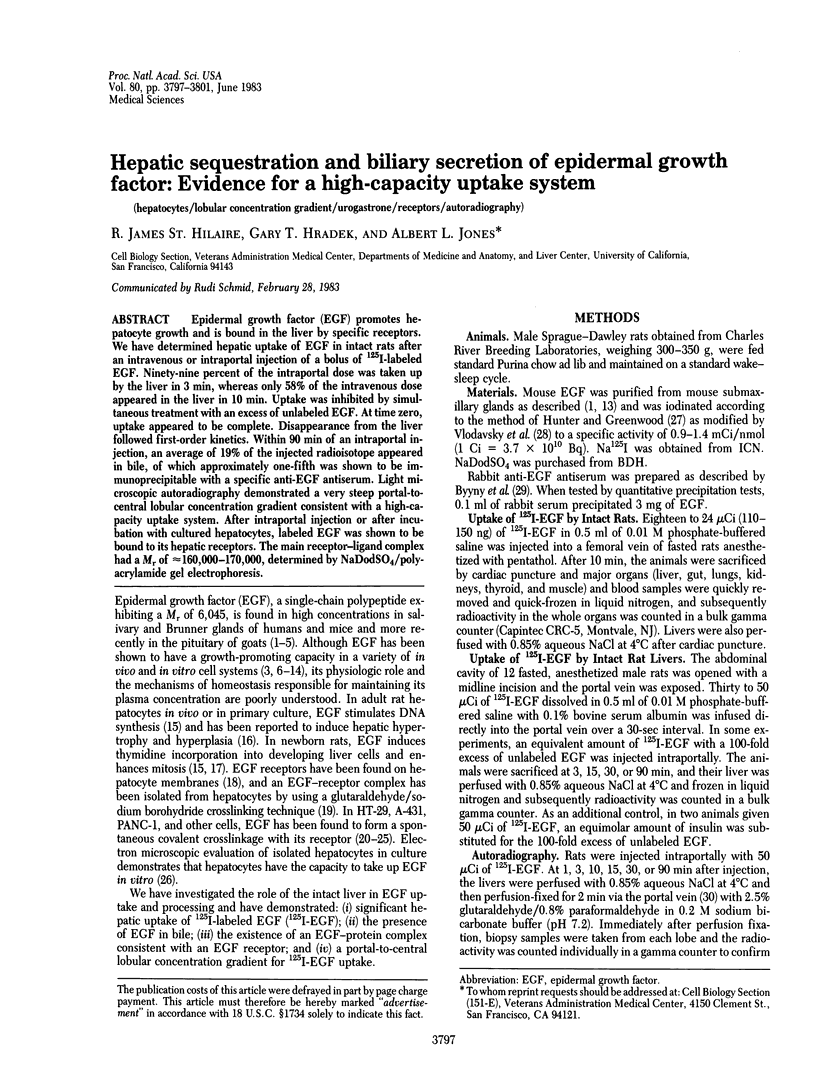
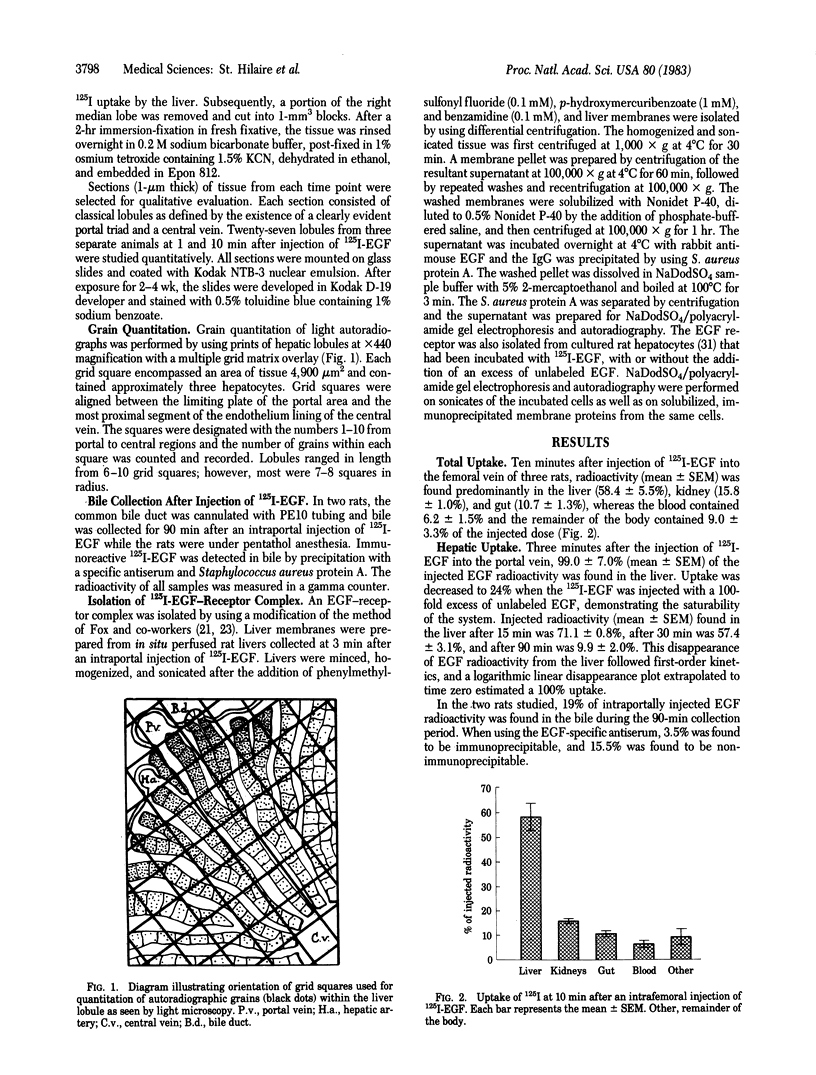
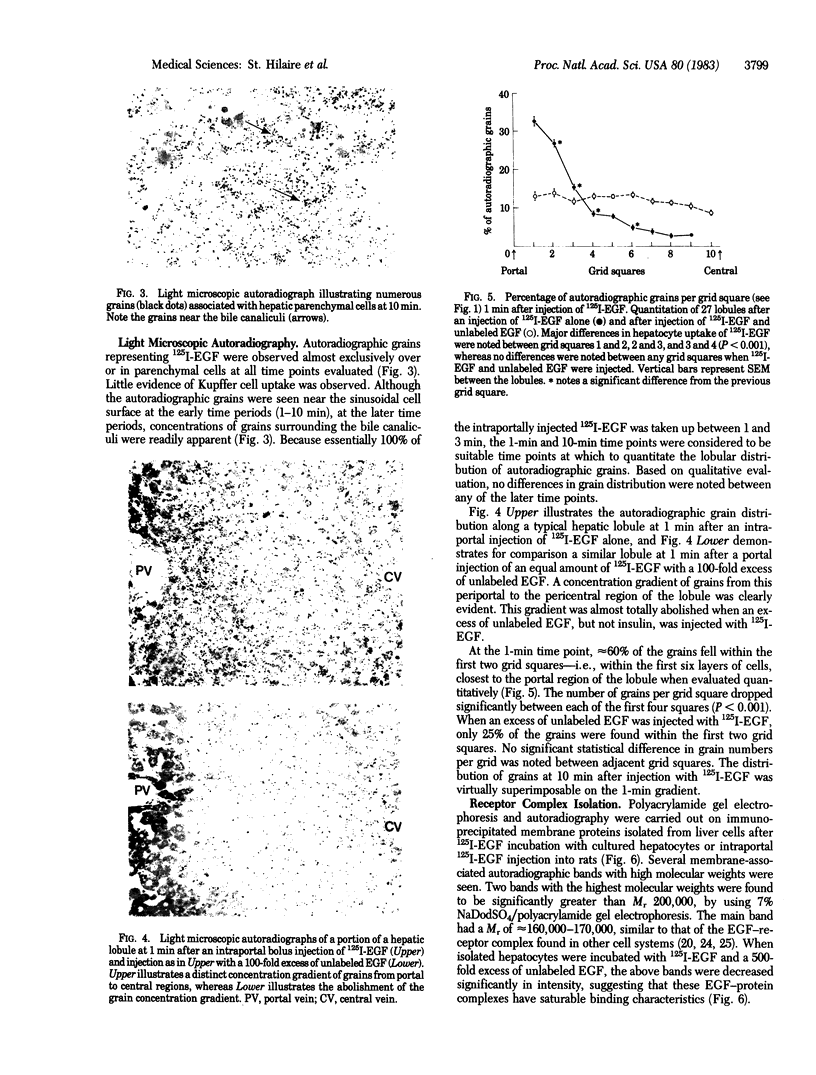
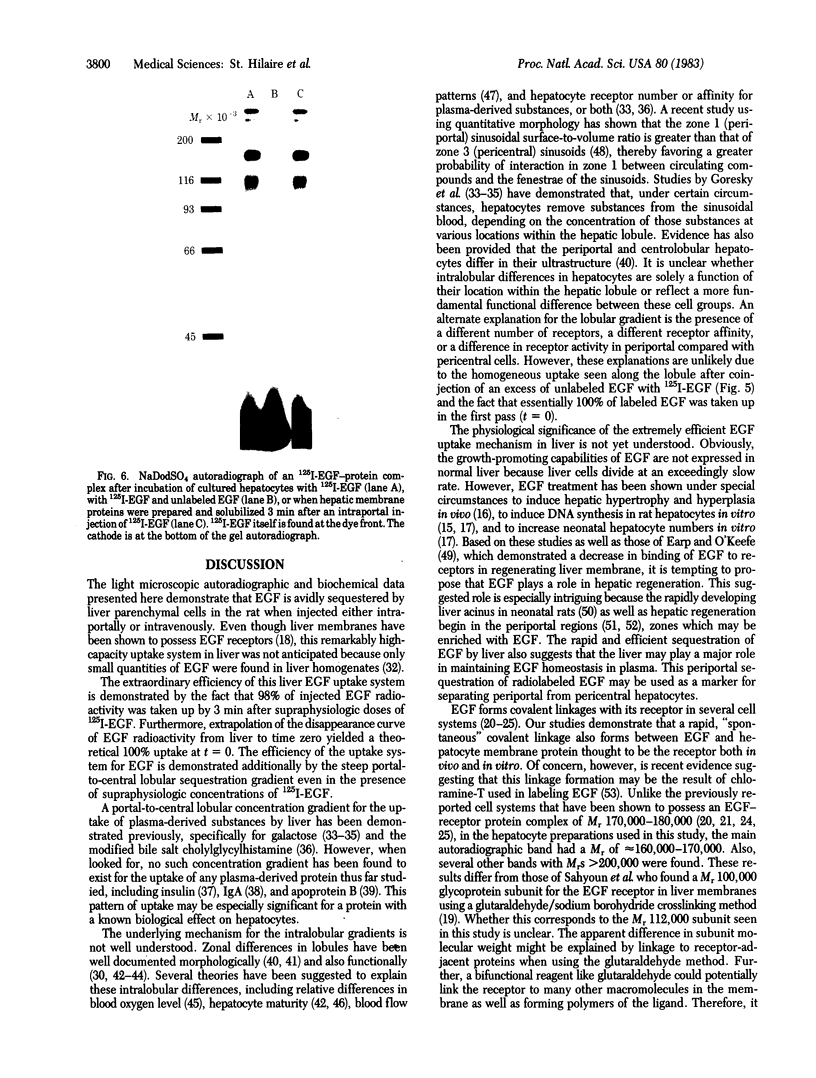
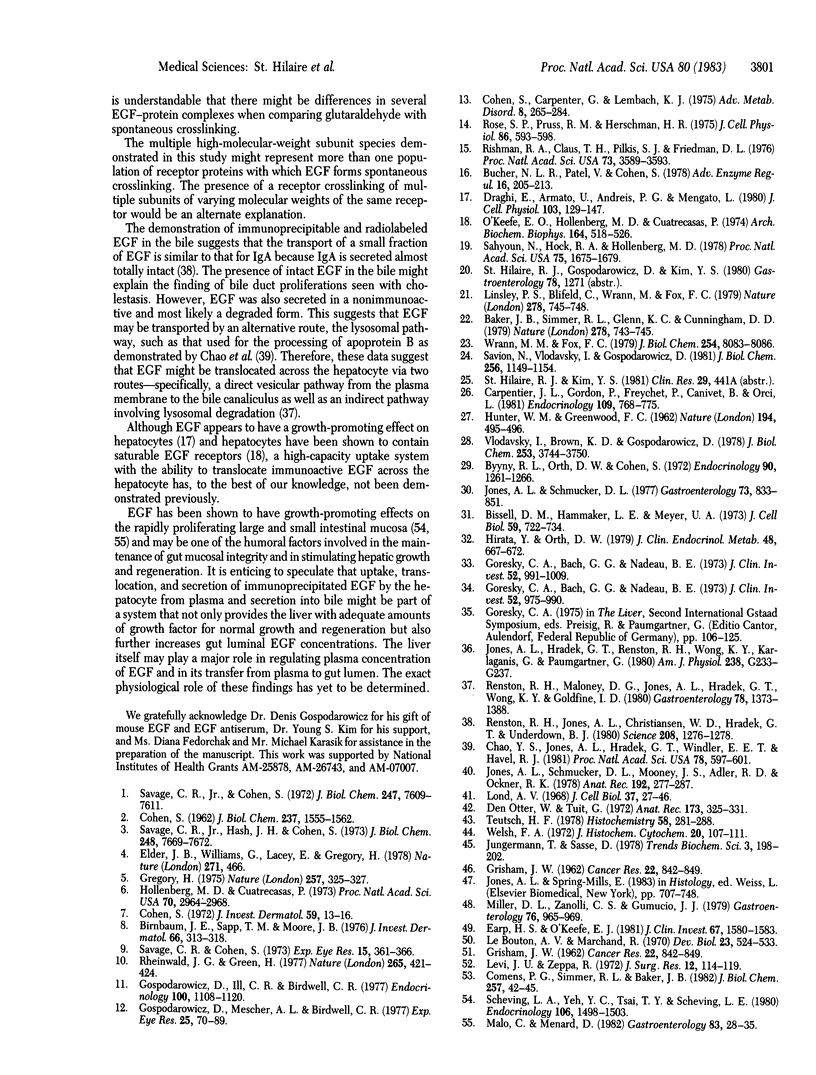
Images in this article
Selected References
These references are in PubMed. This may not be the complete list of references from this article.
- Baker J. B., Simmer R. L., Glenn K. C., Cunningham D. D. Thrombin and epidermal growth factor become linked to cell surface receptors during mitogenic stimulation. Nature. 1979 Apr 19;278(5706):743–745. doi: 10.1038/278743a0. [DOI] [PubMed] [Google Scholar]
- Birnbaum J. E., Sapp T. M., Moore J. B., Jr Effects of reserpine, epidermal growth factor, and cyclic nucleotide modulators on epidermal mitosis. J Invest Dermatol. 1976 May;66(5):313–318. doi: 10.1111/1523-1747.ep12482297. [DOI] [PubMed] [Google Scholar]
- Bissell D. M., Hammaker L. E., Meyer U. A. Parenchymal cells from adult rat liver in nonproliferating monolayer culture. I. Functional studies. J Cell Biol. 1973 Dec;59(3):722–734. doi: 10.1083/jcb.59.3.722. [DOI] [PMC free article] [PubMed] [Google Scholar]
- Bucher N. L., Patel U., Cohen S. Hormonal factors and liver growth. Adv Enzyme Regul. 1977 Oct 3;16:205–213. doi: 10.1016/0065-2571(78)90074-2. [DOI] [PubMed] [Google Scholar]
- Byyny R. L., Orth D. N., Cohen S. Radioimmunoassay of epidermal growth factor. Endocrinology. 1972 May;90(5):1261–1266. doi: 10.1210/endo-90-5-1261. [DOI] [PubMed] [Google Scholar]
- COHEN S. Isolation of a mouse submaxillary gland protein accelerating incisor eruption and eyelid opening in the new-born animal. J Biol Chem. 1962 May;237:1555–1562. [PubMed] [Google Scholar]
- Carpentier J. L., Gorden P., Freychet P., Canivet B., Orci L. The fate of [125I]iodoepidermal growth factor in isolated hepatocytes: a quantitative electron microscopic autoradiographic study. Endocrinology. 1981 Sep;109(3):768–775. doi: 10.1210/endo-109-3-768. [DOI] [PubMed] [Google Scholar]
- Chao Y. S., Jones A. L., Hradek G. T., Windler E. E., Havel R. J. Autoradiographic localization of the sites of uptake, cellular transport, and catabolism of low density lipoproteins in the liver of normal and estrogen-treated rats. Proc Natl Acad Sci U S A. 1981 Jan;78(1):597–601. doi: 10.1073/pnas.78.1.597. [DOI] [PMC free article] [PubMed] [Google Scholar]
- Cohen S., Carpenter G., Lembach K. J. Interaction of epidermal growth factor (EGF) with cultured fibroblasts. Adv Metab Disord. 1975;8:265–284. doi: 10.1016/b978-0-12-027308-9.50024-x. [DOI] [PubMed] [Google Scholar]
- Cohen S. Epidermal growth factor. J Invest Dermatol. 1972 Jul;59(1):13–16. doi: 10.1111/1523-1747.ep12625690. [DOI] [PubMed] [Google Scholar]
- Comens P. G., Simmer R. L., Baker J. B. Direct linkage of 125I-EGF to cell surface receptors. A useful artifact of chloramine-T treatment. J Biol Chem. 1982 Jan 10;257(1):42–45. [PubMed] [Google Scholar]
- Draghi E., Armato U., Andreis P. G., Mengato L. The stimulation by epidermal growth factor (urogastrone) of the growth of neonatal rat hepatocytes in primary tissue culture and its modulation by serum and associated pancreatic hormones. J Cell Physiol. 1980 Apr;103(1):129–147. doi: 10.1002/jcp.1041030118. [DOI] [PubMed] [Google Scholar]
- Earp H. S., O'Keefe E. J. Epidermal growth factor receptor number decreases during rat liver regeneration. J Clin Invest. 1981 May;67(5):1580–1583. doi: 10.1172/JCI110190. [DOI] [PMC free article] [PubMed] [Google Scholar]
- Elder J. B., Williams G., Lacey E., Gregory H. Cellular localisation of human urogastrone/epidermal growth factor. Nature. 1978 Feb 2;271(5644):466–467. doi: 10.1038/271466a0. [DOI] [PubMed] [Google Scholar]
- GRISHAM J. W. A morphologic study of deoxyribonucleic acid synthesis and cell proliferation in regenerating rat liver; autoradiography with thymidine-H3. Cancer Res. 1962 Aug;22:842–849. [PubMed] [Google Scholar]
- GRISHAM J. W. A morphologic study of deoxyribonucleic acid synthesis and cell proliferation in regenerating rat liver; autoradiography with thymidine-H3. Cancer Res. 1962 Aug;22:842–849. [PubMed] [Google Scholar]
- Goresky C. A., Bach G. C., Nadeau B. E. On the uptake of materials by the intact liver. The concentrative transport of rubidium-86. J Clin Invest. 1973 May;52(5):975–990. doi: 10.1172/JCI107299. [DOI] [PMC free article] [PubMed] [Google Scholar]
- Goresky C. A., Bach G. G., Nadeau B. E. On the uptake of materials by the intact liver. The transport and net removal of galactose. J Clin Invest. 1973 May;52(5):991–1009. doi: 10.1172/JCI107300. [DOI] [PMC free article] [PubMed] [Google Scholar]
- Gospodarowicz D., Ill C. R., Birdwell C. R. Effects of fibroblast and epidermal growth factors on ovarian cell proliferation in vitro. I. Characterization of the response of granulosa cells to FGF and EGF. Endocrinology. 1977 Apr;100(4):1108–1120. doi: 10.1210/endo-100-4-1108. [DOI] [PubMed] [Google Scholar]
- Gospodarowicz D., Mescher A. L., Birdwell C. R. Stimulation of corneal endothelial cell proliferations in vitro by fibroblast and epidermal growth factors. Exp Eye Res. 1977 Jul;25(1):75–89. doi: 10.1016/0014-4835(77)90248-2. [DOI] [PubMed] [Google Scholar]
- Gregory H. Isolation and structure of urogastrone and its relationship to epidermal growth factor. Nature. 1975 Sep 25;257(5524):325–327. doi: 10.1038/257325a0. [DOI] [PubMed] [Google Scholar]
- HUNTER W. M., GREENWOOD F. C. Preparation of iodine-131 labelled human growth hormone of high specific activity. Nature. 1962 May 5;194:495–496. doi: 10.1038/194495a0. [DOI] [PubMed] [Google Scholar]
- Hirata Y., Orth D. N. Epidermal growth factor (urogastrone) in human tissues. J Clin Endocrinol Metab. 1979 Apr;48(4):667–672. doi: 10.1210/jcem-48-4-667. [DOI] [PubMed] [Google Scholar]
- Hollenberg M. D., Cuatrecasas P. Epidermal growth factor: receptors in human fibroblasts and modulation of action by cholera toxin. Proc Natl Acad Sci U S A. 1973 Oct;70(10):2964–2968. doi: 10.1073/pnas.70.10.2964. [DOI] [PMC free article] [PubMed] [Google Scholar]
- Jones A. L., Hradek G. T., Renston R. H., Wong K. Y., Karlaganis G., Paumgartner G. Autoradiographic evidence for hepatic lobular concentration gradient of bile acid derivative. Am J Physiol. 1980 Mar;238(3):G233–G237. doi: 10.1152/ajpgi.1980.238.3.G233. [DOI] [PubMed] [Google Scholar]
- Jones A. L., Schmucker D. L. Current concepts of liver structure as related to function. Gastroenterology. 1977 Oct;73(4 Pt 1):833–851. [PubMed] [Google Scholar]
- Jones A. L., Schmucker D. L., Mooney J. S., Adler R. D., Ockner R. K. A quantitative analysis of hepatic ultrastructure in rats during enhanced bile secretion. Anat Rec. 1978 Oct;192(2):277–287. doi: 10.1002/ar.1091920208. [DOI] [PubMed] [Google Scholar]
- LeBouton A. V., Marchand R. Changes in the distribution of thymidine-3H labeled cells in the growing liver acinus of neonatal rats. Dev Biol. 1970 Dec;23(4):524–533. doi: 10.1016/0012-1606(70)90138-7. [DOI] [PubMed] [Google Scholar]
- Levi J. U., Zeppa R. The response of normal rat hepatocytes when exposed to humoral (regenerating) factor. J Surg Res. 1972 Feb;12(2):114–119. doi: 10.1016/0022-4804(72)90130-8. [DOI] [PubMed] [Google Scholar]
- Linsley P. S., Blifeld C., Wrann M., Fox C. F. Direct linkage of epidermal growth factor to its receptor. Nature. 1979 Apr 19;278(5706):745–748. doi: 10.1038/278745a0. [DOI] [PubMed] [Google Scholar]
- Loud A. V. A quantitative stereological description of the ultrastructure of normal rat liver parenchymal cells. J Cell Biol. 1968 Apr;37(1):27–46. doi: 10.1083/jcb.37.1.27. [DOI] [PMC free article] [PubMed] [Google Scholar]
- Malo C., Ménard D. Influence of epidermal growth factor on the development of suckling mouse intestinal mucosa. Gastroenterology. 1982 Jul;83(1 Pt 1):28–35. [PubMed] [Google Scholar]
- Miller D. L., Zanolli C. S., Gumucio J. J. Quantitative morphology of the sinusoids of the hepatic acinus. Quantimet analysis of rat liver. Gastroenterology. 1979 May;76(5 Pt 1):965–969. [PubMed] [Google Scholar]
- O'Keefe E., Hollenberg M. D., Cuatrecasas P. Epidermal growth factor. Characteristics of specific binding in membranes from liver, placenta, and other target tissues. Arch Biochem Biophys. 1974 Oct;164(2):518–526. doi: 10.1016/0003-9861(74)90062-9. [DOI] [PubMed] [Google Scholar]
- Renston R. H., Jones A. L., Christiansen W. D., Hradek G. T., Underdown B. J. Evidence for a vesicular transport mechanism in hepatocytes for biliary secretion of immunoglobulin A. Science. 1980 Jun 13;208(4449):1276–1278. doi: 10.1126/science.7375938. [DOI] [PubMed] [Google Scholar]
- Renston R. H., Maloney D. G., Jones A. L., Hradek G. T., Wong K. Y., Goldfine I. D. Bile secretory apparatus: evidence for a vesicular transport mechanism for proteins in the rat, using horseradish peroxidase and [125I]insulin. Gastroenterology. 1980 Jun;78(6):1373–1388. [PubMed] [Google Scholar]
- Rheinwald J. G., Green H. Epidermal growth factor and the multiplication of cultured human epidermal keratinocytes. Nature. 1977 Feb 3;265(5593):421–424. doi: 10.1038/265421a0. [DOI] [PubMed] [Google Scholar]
- Richman R. A., Claus T. H., Pilkis S. J., Friedman D. L. Hormonal stimulation of DNA synthesis in primary cultures of adult rat hepatocytes. Proc Natl Acad Sci U S A. 1976 Oct;73(10):3589–3593. doi: 10.1073/pnas.73.10.3589. [DOI] [PMC free article] [PubMed] [Google Scholar]
- Rose S. P., Pruss R. M., Herschman H. R. Initiation of 3T3 fibroblast cell division by epidermal growth factor. J Cell Physiol. 1975 Dec;86 (Suppl 2)(3 Pt 2):593–598. doi: 10.1002/jcp.1040860504. [DOI] [PubMed] [Google Scholar]
- Sahyoun N., Hock R. A., Hollenberg M. D. Insulin and epidermal growth factor-urogastrone: affinity crosslinking to specific binding sites in rat liver membranes. Proc Natl Acad Sci U S A. 1978 Apr;75(4):1675–1679. doi: 10.1073/pnas.75.4.1675. [DOI] [PMC free article] [PubMed] [Google Scholar]
- Savage C. R., Jr, Cohen S. Epidermal growth factor and a new derivative. Rapid isolation procedures and biological and chemical characterization. J Biol Chem. 1972 Dec 10;247(23):7609–7611. [PubMed] [Google Scholar]
- Savage C. R., Jr, Cohen S. Proliferation of corneal epithelium induced by epidermal growth factor. Exp Eye Res. 1973 Mar;15(3):361–366. doi: 10.1016/0014-4835(73)90151-6. [DOI] [PubMed] [Google Scholar]
- Savage C. R., Jr, Hash J. H., Cohen S. Epidermal growth factor. Location of disulfide bonds. J Biol Chem. 1973 Nov 25;248(22):7669–7672. [PubMed] [Google Scholar]
- Savion N., Vlodavsky I., Gospodarowicz D. Nuclear accumulation of epidermal growth factor in cultured bovine corneal endothelial and granulosa cells. J Biol Chem. 1981 Feb 10;256(3):1149–1154. [PubMed] [Google Scholar]
- Scheving L. A., Yeh Y. C., Tsai T. H., Scheving L. E. Circadian phase-dependent stimulatory effects of epidermal growth factor on deoxyribonucleic acid synthesis in the duodenum, jejunum, ileum, caecum, colon, and rectum of the adult male mouse. Endocrinology. 1980 May;106(5):1498–1503. doi: 10.1210/endo-106-5-1498. [DOI] [PubMed] [Google Scholar]
- Teutsch H. F. Quantitative determination of G6Pase activity in histochemically defined zones of the liver acinus. Histochemistry. 1978 Dec 13;58(4):281–288. doi: 10.1007/BF00495384. [DOI] [PubMed] [Google Scholar]
- Vlodavsky I., Brown K. D., Gospodarowicz D. A comparison of the binding of epidermal growth factor to cultured granulosa and luteal cells. J Biol Chem. 1978 May 25;253(10):3744–3750. [PubMed] [Google Scholar]
- Welsh F. A. Changes in distribution of enzymes within the liver lobule during adaptive increases. J Histochem Cytochem. 1972 Feb;20(2):107–111. doi: 10.1177/20.2.107. [DOI] [PubMed] [Google Scholar]
- Wrann M. M., Fox C. F. Identification of epidermal growth factor receptors in a hyperproducing human epidermoid carcinoma cell line. J Biol Chem. 1979 Sep 10;254(17):8083–8086. [PubMed] [Google Scholar]
- den Otter W., Tuit G. Causes of the zonal distribution of glycogen in the liver acinus after a fat-rich diet. I. Glycogen deposition in the acini of rat livers during "normal" and "reversed" perfusion. Anat Rec. 1972 Jul;173(3):325–331. doi: 10.1002/ar.1091730307. [DOI] [PubMed] [Google Scholar]






